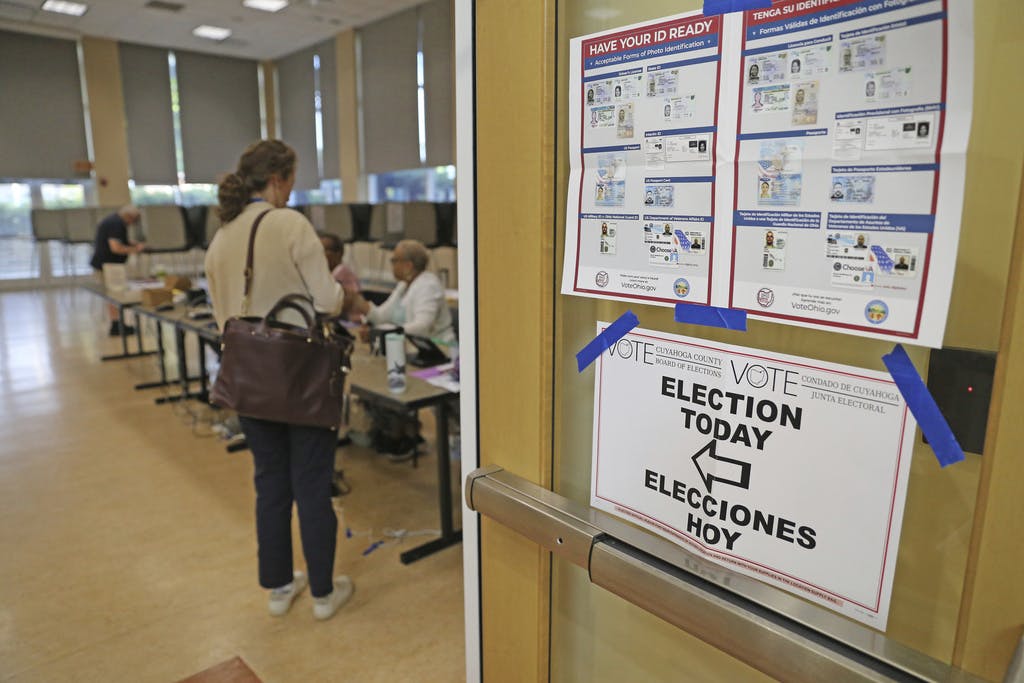Ohio Votes on Bellwether Referendum That Would Make It Harder To Protect Abortion Rights
‘Issue 1,’ as the referendum is known, would make it harder for voters to add amendments to the state constitution.

In an election that will have major implications for everything from abortion rights to redistricting to gun rights, Ohio voters on Tuesday will determine how citizens will be able to amend their state constitution.
“Issue 1” is the ballot question at hand. If approved, future proposed amendments to the Ohio constitution will require 60 percent of the vote to successfully pass — up from the simple majority that is currently needed. The immediate effect of this referendum, should it pass, would be to make it harder for Ohionans to enshrine the right to an abortion in their state constitution. A referendum to do just that will be voted on later this year.
Republicans in the Ohio legislature sent Issue 1 to the voters back in May, setting up an unusual mid-August special election. Democrats say the vote itself is illegal because the GOP-controlled legislature banned August special elections during the last legislative session.
“This amendment would destroy citizen-driven ballot initiatives as we know them, upending our right to make decisions that directly impact our lives,” six Democratic members of the Ohio legislature wrote in their opposition notice regarding the ballot. “It takes away our freedom by undermining the sacred principle of ‘one person, one vote’ and destroys majority rule in Ohio.”
Some opposition to the affirmation of Issue 1 is bipartisan. Ohio’s four living former governors — Republicans John Kasich and Bob Taft, and Democrats Ted Strickland and Dick Celeste — have all come out against the measure.
Mr. Taft — a scion of the Taft Republican dynasty as the son and grandson of U.S. senators and great-grandson of President Taft — said he could not support such a “major change” to the process of citizens amending their state constitution. “Such a dramatic change in the Ohio Constitution should not be accomplished in an extremely low turnout election,” he told the Sandusky Register.
Mr. Celeste, who served as governor between 1983 and 1991, said he was “stunned” when he read the text of Issue 1. Beyond the increased threshold to 60 percent from 50, Issue 1 would require signatures of support from all of Ohio’s 88 counties for those seeking to get a proposed constitutional amendment on the statewide ballot.
“One or two small counties could block the effort to put a serious issue on the ballot,” Mr. Celeste told the Register. “It’s clear that what they’re trying to do is muzzle the voice of the people.”
The state’s incumbent governor, Republican Mike DeWine, supports the measure’s passage.
The rationale for the vote on Tuesday, Republicans say, is to make it easier to defeat a November ballot question that will determine the future of abortion rights in the state. Ohio’s secretary of state, Frank LaRose, said Issue 1 is “100 percent” driven by the hopes of defeating the November abortion rights question.
“Some people say, ‘This is all about abortion,’” Mr. LaRose, who is running for the U.S. Senate, told a Republican crowd on May 22. “Well, you know what, I’m pro-life. I think many of you are as well, right? This is 100 percent about keeping a radical, pro-abortion amendment out of our constitution. The left wants to jam it in there this coming November.”
Abortion rights advocates in Ohio are hoping to affirm with a November ballot question that abortion is legal in the state. If it wins this fall — either with the current 50 percent threshold or the 60 percent should Issue 1 be affirmed Tuesday — then abortion would remain legal even after a fetus is viable. Following the Dobbs v. Jackson Women’s Health Organization decision from the Supreme Court last year that overturned Roe v. Wade, Ohio adopted a 22-week abortion ban, which was later halted by a state court.
The proposed abortion rights amendment states that every “individual has a right to make and carry out one’s own reproductive decisions, including but not limited to decisions on: contraception; fertility treatment; continuing one’s own pregnancy; miscarriage care; and abortion.”
The anti-abortion rights group Protect Women Ohio has spent nearly $9 million on the Issue 1 campaign, hoping to make it easier to defeat the abortion referendum in November. “At its core, it’s about keeping out-of-state special interest groups from buying their way into our constitution, which we’re seeing happen far too often,” the organization’s press secretary, Amy Natoce, told Fox News Digital. “They’re circumventing the legislative process and going directly after the constitution.”
Issue 1 has seen huge sums of money spent both in opposition and support in the months leading up to Tuesday’s vote. In total, those opposing the measure have spent more than $12 million while the supporting side has expended just over $11 million. For comparison, Senator Vance’s successful 2022 campaign spent just under $15 million in the Buckeye State.

